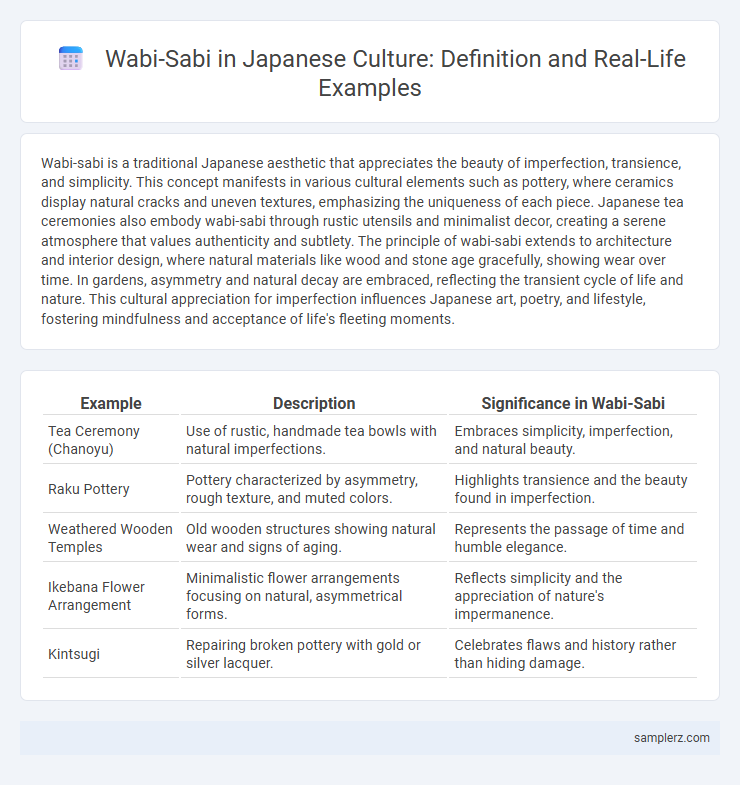Wabi-sabi is a traditional Japanese aesthetic that appreciates the beauty of imperfection, transience, and simplicity. This concept manifests in various cultural elements such as pottery, where ceramics display natural cracks and uneven textures, emphasizing the uniqueness of each piece. Japanese tea ceremonies also embody wabi-sabi through rustic utensils and minimalist decor, creating a serene atmosphere that values authenticity and subtlety. The principle of wabi-sabi extends to architecture and interior design, where natural materials like wood and stone age gracefully, showing wear over time. In gardens, asymmetry and natural decay are embraced, reflecting the transient cycle of life and nature. This cultural appreciation for imperfection influences Japanese art, poetry, and lifestyle, fostering mindfulness and acceptance of life's fleeting moments.
Table of Comparison
| Example | Description | Significance in Wabi-Sabi |
|---|---|---|
| Tea Ceremony (Chanoyu) | Use of rustic, handmade tea bowls with natural imperfections. | Embraces simplicity, imperfection, and natural beauty. |
| Raku Pottery | Pottery characterized by asymmetry, rough texture, and muted colors. | Highlights transience and the beauty found in imperfection. |
| Weathered Wooden Temples | Old wooden structures showing natural wear and signs of aging. | Represents the passage of time and humble elegance. |
| Ikebana Flower Arrangement | Minimalistic flower arrangements focusing on natural, asymmetrical forms. | Reflects simplicity and the appreciation of nature's impermanence. |
| Kintsugi | Repairing broken pottery with gold or silver lacquer. | Celebrates flaws and history rather than hiding damage. |
The Essence of Wabi-Sabi in Japanese Aesthetics
Wabi-sabi embodies the appreciation of imperfection, impermanence, and simplicity in Japanese aesthetics, valuing natural materials and handcrafted objects that show signs of aging. Traditional tea ceremonies highlight this essence by using rustic, imperfect tea bowls that embrace asymmetry and subtle irregularities. The philosophy underscores beauty found in transience and authenticity, reflecting a deep cultural reverence for nature's cycles.
Wabi-Sabi in Traditional Japanese Tea Ceremonies
Wabi-sabi in traditional Japanese tea ceremonies embodies the appreciation of imperfection and transience through rustic, handmade tea bowls with asymmetrical shapes and natural textures. The serene tea room design emphasizes simplicity, muted colors, and organic materials, highlighting the beauty of impermanence. This aesthetic philosophy fosters mindfulness and a deep connection to nature during the tea ritual.
Imperfections in Japanese Pottery and Ceramics
Wabi-sabi in Japanese culture celebrates the beauty of imperfection, particularly evident in pottery and ceramics where asymmetry, rough textures, and natural flaws are embraced as unique characteristics. This philosophy values the transient and imperfect nature of handcrafted objects, highlighting irregular glazes and cracks as marks of authenticity and history. Ceramic artists intentionally preserve these imperfections to reflect the passage of time and the inherent impermanence within their work.
Nature-Inspired Wabi-Sabi in Japanese Garden Design
Wabi-sabi in Japanese garden design emphasizes the beauty found in imperfection and impermanence through natural elements like moss-covered stones, weathered wood, and asymmetrical layouts. This aesthetic highlights the transient nature of life by celebrating organic textures, muted colors, and minimalist arrangements that evoke tranquility and simplicity. The intentional use of aged materials and irregular shapes creates a harmonious environment that embodies the philosophy of embracing natural cycles and imperfection.
Architecture: Simplicity and Transience in Japanese Homes
Wabi-sabi in Japanese architecture embodies simplicity and transience through natural materials, asymmetrical designs, and an emphasis on imperfection and impermanence. Traditional Japanese homes feature elements like tatami mats, shoji screens, and weathered wood that evolve with time, reflecting the beauty of aging and the passage of seasons. This aesthetic fosters a harmonious connection between humanity and nature, promoting mindfulness and acceptance of life's fleeting moments.
Wabi-Sabi Reflected in Japanese Calligraphy and Art
Japanese calligraphy exemplifies wabi-sabi through its emphasis on simplicity, asymmetry, and natural imperfection, capturing the transient beauty of ink strokes on textured paper. Traditional Japanese art often incorporates rough, unrefined surfaces and muted earthy tones to highlight the beauty of impermanence and imperfection. These aesthetics celebrate the organic process, allowing each brushstroke and material flaw to narrate a story of authenticity and quiet elegance.
Everyday Objects: Embracing Wear and Age
Wabi-sabi in Japanese culture finds expression in everyday objects that celebrate imperfection, impermanence, and the beauty of natural aging. Items such as weathered tea bowls, rustic ceramics, and worn wooden furniture showcase cracks, patina, and asymmetry, embodying the aesthetic of transience and authenticity. This appreciation for wear and age underscores a philosophy that values simplicity, humility, and the passage of time in daily life.
Wabi-Sabi in Japanese Literature and Poetry
Wabi-sabi in Japanese literature and poetry emphasizes the beauty of impermanence, imperfection, and simplicity, often reflected in haiku and tanka verses that capture fleeting moments in nature. Poets like Matsuo Basho exemplify wabi-sabi through minimalist imagery and subtle emotional depth, highlighting transient beauty and melancholic serenity. This aesthetic fosters a profound appreciation of the ephemeral, encouraging readers to embrace the imperfect and transient aspects of life.
Seasonal Ephemerality and the Appreciation of Fleeting Beauty
Wabi-sabi in Japanese culture emphasizes the beauty found in seasonal ephemerality, particularly through the delicate cherry blossom (sakura) season, where transient blooms symbolize life's impermanence. This aesthetic values the subtle changes in nature, encouraging deep appreciation for fleeting moments of elegance and melancholic beauty. The celebration of autumn leaves (momiji) further illustrates this principle, highlighting vibrant, transient colors as a metaphor for the passage of time and the acceptance of change.
Modern Interpretations of Wabi-Sabi in Japanese Culture
Modern interpretations of wabi-sabi in Japanese culture emphasize simplicity, natural materials, and the beauty of imperfection in architecture and interior design. Contemporary designers incorporate asymmetry, rough textures, and muted colors to evoke a sense of tranquility and authenticity. This aesthetic philosophy influences everything from minimalist home decor to artisanal crafts, reflecting a timeless appreciation for impermanence and understated elegance.

example of wabi-sabi in Japanese culture Infographic
 samplerz.com
samplerz.com